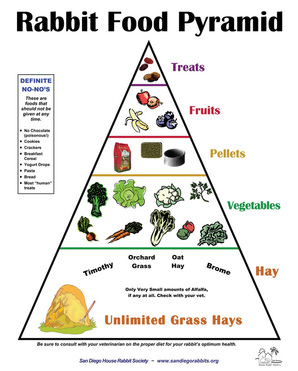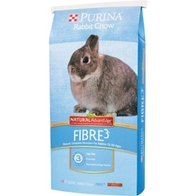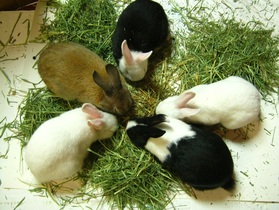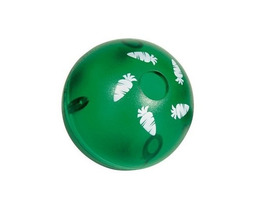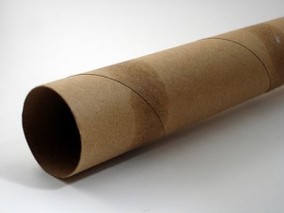PelletsPellets and their role for your disabled rabbit.
Pellets are a smaller but important part of your rabbit's diet. They are designed to be concentrated sources of fiber, protein, vitamins and minerals to help ensure that your rabbit is getting all the nutrients he or she needs. When feeding pellets, it is important to remember that a rabbit's natural diet contains a high volume of low nutrient food. Rabbits are grazers by nature and wild rabbits spend much of their days munching on grass and grazing for food. While pellets enable owners to protect their rabbit's health and give them the range of nutrients they need, they are ultimately a low volume of high nutrient food that runs contrary to a rabbit's wild diet. Therefore, it is important to follow feeding guidelines closely to make sure that they receive as balanced a diet as possible. However, due to the nature of rabbit disabilities and the effects they have on a rabbit's weight and health, owner's of disabled rabbits are encouraged to free feed pellets if their rabbit needs help maintaining his or her weight.
Here are the age guidelines for feeding pellets:
|
Mixes vs Pellets
Mixes
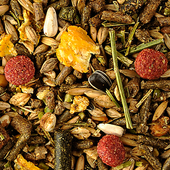
Also known as "muesli," these rabbit food mixes are primarily cereal-based. They contain brightly colored processed pieces and a variety of whole ingredients including oats, corn, beans, dried fruits and nuts- all of which are unnecessary and, in some cases, very unhealthy for rabbits. They are made with colors and textures that are designed to be appealing to humans, not with rabbit nutrition in mind. They tend to be lower in fiber and higher in protein than their pellet counterparts, which is the opposite of what a rabbit needs. Also, feeding a mix allows your rabbit to pick and choose what they like to eat (rabbits are picky after all). If they do not eat all the parts of the food, then they are not receiving a balanced diet full of all the nutrients they need to stay healthy. For these reasons, these mixes are NOT AT ALL recommended for your rabbit.
Pellets
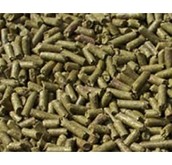
Rabbit pellet foods are usually grass-based using such hays as timothy or alfalfa. The hays and ingredients are processed into uniform 'pellets' for your rabbit to eat. These foods tend to be higher in fiber and lower in protein than muesli-style mixes and complement a rabbit's nutritional needs much more closely. While they may look more 'boring' compared to bright-colored and multi-textured mixes, they most closely resemble what your rabbit needs and most find them perfectly tasty. These pellet foods are recommended for you to feed to your rabbit.
Choosing a Pellet Food
Pet stores have shelves packed with all types of rabbit food, each claiming to be better than the next. There is “gourmet” and “premium,” there are foods saying they are “fortified with vitamins” or that contain “all natural ingredients.” But which do we trust? When it comes to buying for our disabled rabbit, we know the decision is even more important. With so much of their nutrition riding on this choice, it is important that we find a pellet that has a healthy blend of grass base, fiber and vitamins. Don’t be tempted by the advertising. Instead, take a close look at the ingredient list and nutritional analysis on the back of the bag to get a more accurate idea of the health of a particular food. Here is what to look for:
Fiber
The fiber content is the most important part of a food's nutritional content. Fiber is essential for healthy digestion. Disabled rabbits especially need a sufficient amount of fiber. As they tend to not move around as much, they need fiber to help keep their system moving to move things through their gut and prevent gastrointestinal problems such as blockage. So, the higher the fiber content, the better.
- Look for at least 20%, but the ideal would be 25% and up.
Protein
Rabbit's generally need a low to mid-range protein content in their pellets.
- Look for around 12-14%. The exception is if you have a very young rabbit (under 5 months) or an angora breed rabbit. Younger rabbits need a higher protein level (around 16%) to support their rabbit growth. Angoras need a higher protein level (around 16%) to support their long fur.
Fat
Rabbits should have very little fat in their diet.
- Look for around 1-1.5%.
Calcium
Rabbits need very little calcium content in their diets.
- Look for around 1%. However, if your rabbit has or has a history of having bladder, sludge or kidney problems, try to find the lowest calcium content you can, ideally as low as 0.5%.
and the hay used
In general, timothy-based pellets are better for adult rabbits. They contain more fiber and less calcium and protein, as is appropriate for a balanced adult rabbit diet. Alfalfa-based pellets tend to contain more protein and calcium and less fiber. This is appropriate for younger rabbits but can also be appropriate for disabled rabbits that have a reduced appetite and that may be struggling to keep on weight. Think about your rabbit's particular condition when choosing between a timothy-based and an alfalfa-based pellet and consult your veterinarian.
The Foods We Recommend
Oxbow Bunny Basics Adult Rabbit Food
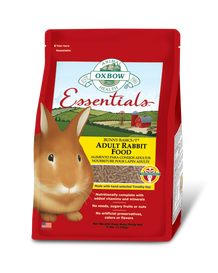
Ingredients: Timothy Grass Meal, Soybean Hulls, Wheat Middlings, Soybean Meal, Cane Molasses, Sodium Bentonite, Soybean Oil, Salt, Lignin Sulfonate, Limestone, Yeast Culture (dehydrated), Vitamin E Supplement, Choline Chloride, Zinc Proteinate, Zinc Sulfate, Ferrous Sulfate, Niacin, Copper Sulfate, Selenium Yeast, Vitamin A Supplement, Folic Acid, d-Calcium Pantothenate, Copper Proteinate, Riboflavin Supplement, Manganese Proteinate, Biotin, Manganous Oxide, Thiamine Mononitrate, Magnesium Sulfate, Vitamin B12 Supplement, Sodium Selenite, Pyridoxine Hydrochloride, Cobalt Carbonate, Vitamin D3 Supplement, Calcium Iodate
Analysis:
Analysis:
- Crude Protein (min) 14.00%
- Crude Fat (min) 2.00%
- Crude Fiber (min) 25.00%
- Crude Fiber (max) 29.00%
- Moisture (max) 10.00%
- Calcium (min) 0.35%
- Calcium (max) 0.85%
- Phosphorus (min) 0.25%
- Copper (min) 30 ppm
- Vitamin A (min) 19,000 IU/kg
- Vitamin D (min) 900 IU/kg
- Vitamin E (min) 190 IU/kg
Oxbow Bunny Basics Young Rabbit Food*
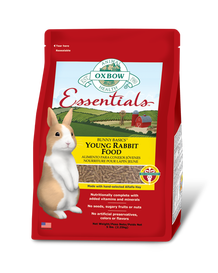
Ingredients: Alfalfa Meal, Soybean Hulls, Wheat Middlings, Soybean Oil, Salt, Cane Molasses, Lignin Sulfonate, Limestone, Yeast Culture (dehydrated), Vitamin E Supplement, Choline Chloride, Zinc Proteinate, Zinc Sulfate, Ferrous Sulfate, Niacin, Copper Sulfate, Selenium Yeast, Vitamin A Supplement, Folic Acid, d-Calcium Pantothenate, Copper Proteinate, Riboflavin Supplement, Manganese Proteinate, Biotin, Manganous Oxide, Thiamine Mononitrate, Magnesium Sulfate, Vitamin B12 Supplement, Sodium Selenite, Pyridoxine Hydrochloride, Cobalt Carbonate, Vitamin D3 Supplement, Calcium Iodate
Analysis:
*We use this food for our disabled adult rabbit as she struggles with maintaining weight. In this case, alfalfa-based food is okay for an adult rabbit.
Analysis:
- Crude Protein (min) 15.00%
- Crude Fat (min) 2.50%
- Crude Fiber (min) 22.00%
- Crude Fiber (max) 25.00%
- Moisture (max) 10.00%
- Calcium (min) 0.50%
- Calcium (max) 1.00%
- Phosphorus (min) 0.25%
- Copper (min) 30 ppm
- Vitamin A (min) 19,000 IU/kg
- Vitamin D (min) 900 IU/kg
- Vitamin E (min) 190 IU/kg
*We use this food for our disabled adult rabbit as she struggles with maintaining weight. In this case, alfalfa-based food is okay for an adult rabbit.
Purina Rabbit Chow Fibre3*
|
Ingredients: Dehydrated Alfalfa Meal, Ground Soybean Hulls, Wheat Middlings, Dehulled Soybean Meal, Cane Molasses, Ground Oat Hulls, Wheat Flour, Monocalcium Phosphate, Dicalcium Phosphate, Salt, Soybean Oil, DL-Methionine, Iron Oxide, Copper Sulfate, DL-Alpha Tocopheryl Acetate, Pyridoxine Hydrochloride, Menadione Sodium Bisulfite Complex, Calcium Pantothenate, Nicotinic Acid, Vitamin A Acetate, Riboflavin, Yeast Culture, Biotin, Dried Aspergillus Niger Fermentation Extract, Thiamine Mononitrate, Folic Acid, Vitamin B12 Supplement, Dried Yeast, Dried Enterococcus Faecium Fermentation Product, Dried Lactobacillus Acidophilus Ferment Product, Dried Yucca Shidigera Extract, Cholecalciferol, Cobalt Carbonate, Manganese Sulfate, Ethylenediamine Dihydriodide, Zinc Sulfate, Copper Chloride, Calcium Carbonate, Sodium Selenite.
Analysis:
*This food is appropriate for a disabled rabbit that may be struggling to maintain weight. |
Encouraging Your Disabled Rabbit to Eat More Pellets
Given the struggles your disabled rabbit faces on a daily basis, it can be hard to get them to focus on healthy eating. However, not eating enough pellets puts them at risk of missing out on critical fiber, vitamins and nutrients that they need during this time to help them heal and stay healthy and strong. So, making an effort to entice them to eat more pellets has real health benefits. Here are some tips for encouraging your rabbit to eat more pellets:
- Make sure pellets are accessible to them. This is especially important for the disabled rabbit. A disabled rabbit may have trouble moving towards where their pellets are located or may not be able to reach into a tall dish or crock. This means that they will need you to place their pellets in easy-to-navigate dishes and places. If their pellets are out of reach, they may not be eating as much as they need to, so make sure you make them accessible.
- Incorporate pellets into toys and games. Try to turn your rabbit's pellets into something fun and exciting. If your rabbit is still able to use tunnels, put some pellets inside. Take a paper towel roll, fold in one end so it's closed, place in a small amount of pellets and then close the other end. They will nudge it about, hear it rattle, wonder what's inside and have to work to get them out. One that we use: If they are interested in and still able to play with toys, put a palm-full of pellets inside a ball that has a few small holes in it. Your rabbit will nose-bump the ball and pellets will fall out. This is a great exercise for their mind AND tummy!
- Use pellets as treats. When they come when called or perk up when you come by, praise them with a gentle voice and a pellet treat. Use pellets to encourage them to move about or as a reward after a nail trim. This makes their pellets more fun!
- Place pellets in various places around their enclosure. Remember- rabbits are foragers. It is in their instincts to 'scavenge' for food and spend much of the day eating bits here and there. It may be more mess, but try putting some pellets under their dolls or in various spots around their cage. It makes their pellets something more exciting than something that just sits in a bowl and it plays off of their foraging instincts.

